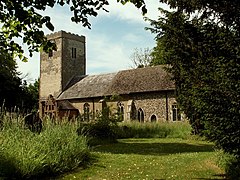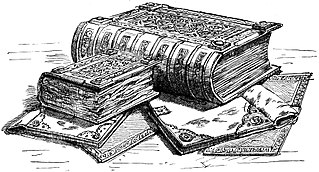
Norton is a village and civil parish in the Mid Suffolk district of the English county of Suffolk. The name Norton means northern town or farm. Located close to the A14, its nearest railway station is at Elmswell, just over 3 miles (5 km) away. The closest towns are Stowmarket 8 miles (13 km) away and Bury St Edmunds, around 10 miles (16 km) away.
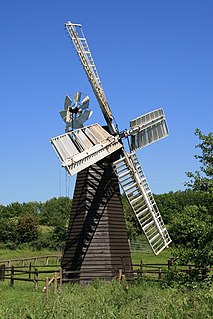
Stowmarket is a small market town in Suffolk, England, on the busy A14 trunk road between Bury St Edmunds to the west and Ipswich to the southeast. The town is on the main railway line between London and Norwich, and lies on the River Gipping, which is joined by its tributary, the River Rat, to the south of the town.

Bramfield is a village and civil parish in the east of the English county of Suffolk. It is 5 miles (8.0 km) south of the market town of Halesworth on the A144 road between Halesworth and the A12 road, one of the main arterial routes through the county. The village is 24 miles (39 km) north-east of the county town of Ipswich and 15 miles (24 km) south-west of the port of Lowestoft. The East Suffolk railway line between Lowestoft and Ipswich passes close to the west of the village with Halesworth railway station being the nearest station.

Baylham is a village and civil parish in the Mid Suffolk district of Suffolk, England, about 7 miles (11 km) northwest of Ipswich and 6 miles (9.7 km) southeast of Stowmarket. It is recorded in the Domesday book as Beleham.

Beyton is a village and civil parish in the Mid Suffolk district of the English county of Suffolk. The village is around 8 miles (13 km) east of Bury St Edmunds, 2 miles (3.2 km) south-east of Thurston and 8 miles (13 km) north-west of Stowmarket. The main Ipswich to Bury St Edmunds road used to pass through the village – the modern A14 dual carriageway bypasses the village to the north.
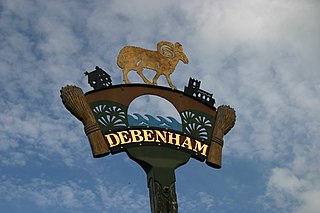
Debenham is a village and civil parish in the Mid Suffolk district of Suffolk, England. The River Deben rises in the parish, and flows along a prolonged ford through the village.

Onehouse is a small village in the English county of Suffolk, about 3 miles west from the centre of Stowmarket near to the Golf Club. The population of the parish at the 2011 Census was 810.

Trimley St. Mary is a parish and village on the outskirts of Felixstowe, on a low-lying peninsula between Harwich Harbour and the River Deben, in Suffolk, England. It lies on the Roman road between Felixstowe and Ipswich. Its eastern border is Spriteshall Lane. The village, and its neighbour Trimley St. Martin, are famous for their adjacent churches, which were built as the result of a historical family feud. St. Mary's church is the southerly church. The village has a number of shops, and two pubs. Trimley railway station serves the village on the Felixstowe Branch Line.

Willisham is a small village in the suburbs of the county town of Ipswich, Suffolk. The small parish village has been present since the 11th century and was included in the Domesday Book. During the 18th century the village was once home to wheat and barley farmers. During the year 2000 the village had 9 new houses built down Tye. The village post office was renovated into a house 8 years ago. The 2011 census recorded a population of 362 people.

Monk Soham is a village in Suffolk, eastern England, four miles (6.4 km) northeast of Debenham and six miles (10 km) northwest of Framlingham. The neighbouring villages are Bedfield, Ashfield cum Thorpe, Kenton and Bedingfield. The nearest primary school is in Bedfield. There are secondary schools in Framlingham and Woodbridge.

Semer is a small village and civil parish in Suffolk, England. Located adjacent to a bridge over the River Brett on the B1115 between Hadleigh and Stowmarket, it is part of Babergh district. The parish also contains the hamlets of Ash Street and Drakestone Green.

Pettaugh is a village and civil parish located within the district council area of Mid Suffolk, England.

Elmswell is a village and civil parish in the county of Suffolk, England. It is situated halfway between Bury St. Edmunds and Stowmarket and lies just to the north of the A14 road.
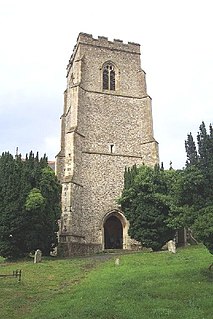
Clopton is a village and civil parish in Suffolk. It is located between Ipswich and Debenham two kilometres north of Grundisburgh on the River Lark. The village is no larger than a series of houses either side of the B1078, surrounded by farm land. The village itself has no clear centre; houses and other buildings are concentrated around the four manors of Kingshall, Brendhall, Rousehall and Wascolies, all of which are mentioned in the Domesday Book.

Stonham Aspal is a village and civil parish in the Mid Suffolk district of Suffolk in eastern England, about five miles east of the town of Stowmarket. Surrounding villages include Mickfield, Little Stonham and Pettaugh. Its population in 2011 was 601. The village has a primary school. It is set in farmland but has a busy main road, A1120, running through the village.
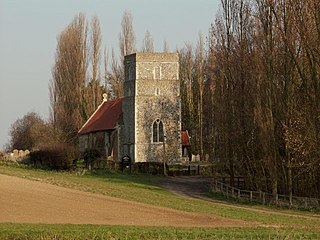
Ringshall is a village and civil parish in the Mid Suffolk district of Suffolk in eastern England. Located around four miles south of Stowmarket, and 13 miles north west of Ipswich.

Ousden is a village and civil parish in the St Edmundsbury district of Suffolk in eastern England. It is located around six miles west of Bury St Edmunds and 72 miles north of London, and as of 2011, its population is 266. The village has an Anglican church of St Peter's and a chapel in the cemetery dedicated to St Barnabas.

Swilland is a village and civil parish, in the Suffolk Coastal district, in the English county of Suffolk. It is north of the large town of Ipswich. Swilland has a church called St Mary. It has a pub called The Moon & Mushroom Inn which has been awarded Suffolk Pub of The Year on two occasions by the Evening Star. The parish formed part of the hundred of Bosmere-and-Claydon.

Stratford St Andrew is a small village and a civil parish just off the A12 road, in the Suffolk Coastal District, in the English county of Suffolk. It is located 3 miles south west of Saxmundham, which is the nearest town to the village.
